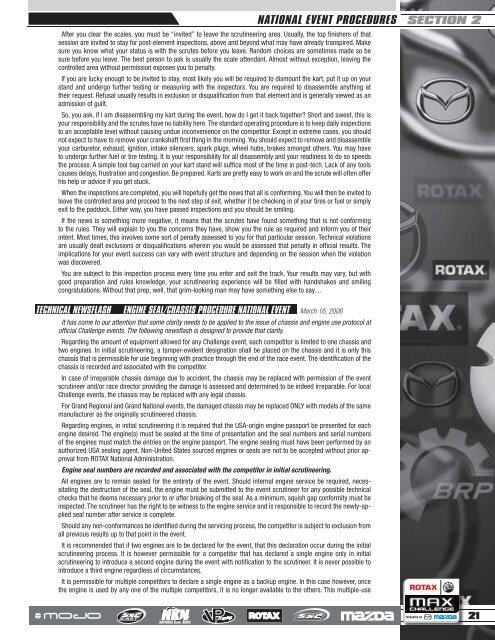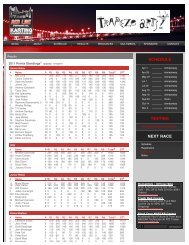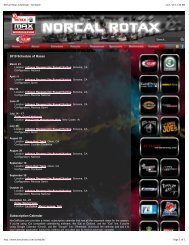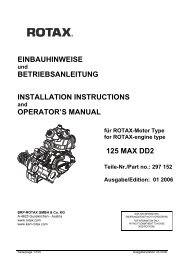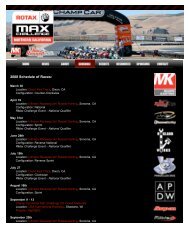technical regulations - Red Line Oil Karting Championships
technical regulations - Red Line Oil Karting Championships
technical regulations - Red Line Oil Karting Championships
Create successful ePaper yourself
Turn your PDF publications into a flip-book with our unique Google optimized e-Paper software.
NATIONAL EVENT PROCEDURES SECTION 2<br />
After you clear the scales, you must be “invited” to leave the scrutineering area. Usually, the top fi nishers of that<br />
session are invited to stay for post-element inspections, above and beyond what may have already transpired. Make<br />
sure you know what your status is with the scrutes before you leave. Random choices are sometimes made so be<br />
sure before you leave. The best person to ask is usually the scale attendant. Almost without exception, leaving the<br />
controlled area without permission exposes you to penalty.<br />
If you are lucky enough to be invited to stay, most likely you will be required to dismount the kart, put it up on your<br />
stand and undergo further testing or measuring with the inspectors. You are required to disassemble anything at<br />
their request. Refusal usually results in exclusion or disqualifi cation from that element and is generally viewed as an<br />
admission of guilt.<br />
So, you ask, if I am disassembling my kart during the event, how do I get it back together Short and sweet, this is<br />
your responsibility and the scrutes have no liability here. The standard operating procedure is to keep daily inspections<br />
to an acceptable level without causing undue inconvenience on the competitor. Except in extreme cases, you should<br />
not expect to have to remove your crankshaft fi rst thing in the morning. You should expect to remove and disassemble<br />
your carburetor, exhaust, ignition, intake silencers, spark plugs, wheel hubs, brakes amongst others. You may have<br />
to undergo further fuel or tire testing. It is your responsibility for all disassembly and your readiness to do so speeds<br />
the process. A simple tool bag carried on your kart stand will suffi ce most of the time in post-tech. Lack of any tools<br />
causes delays, frustration and congestion. Be prepared. Karts are pretty easy to work on and the scrute will often offer<br />
his help or advice if you get stuck.<br />
When the inspections are completed, you will hopefully get the news that all is conforming. You will then be invited to<br />
leave the controlled area and proceed to the next step of exit, whether it be checking in of your tires or fuel or simply<br />
exit to the paddock. Either way, you have passed inspections and you should be smiling.<br />
If the news is something more negative, it means that the scrutes have found something that is not conforming<br />
to the rules. They will explain to you the concerns they have, show you the rule as required and inform you of their<br />
intent. Most times, this involves some sort of penalty assessed to you for that particular session. Technical violations<br />
are usually dealt exclusions or disqualifi cations wherein you would be assessed that penalty in offi cial results. The<br />
implications for your event success can vary with event structure and depending on the session when the violation<br />
was discovered.<br />
You are subject to this inspection process every time you enter and exit the track. Your results may vary, but with<br />
good preparation and rules knowledge, your scrutineering experience will be fi lled with handshakes and smiling<br />
congratulations. Without that prep, well, that grim-looking man may have something else to say…<br />
TECHNICAL NEWSFLASH ENGINE SEAL/CHASSIS PROCEDURE NATIONAL EVENT March 16, 2006<br />
It has come to our attention that some clarity needs to be applied to the issue of chassis and engine use protocol at<br />
offi cial Challenge events. The following newsfl ash is designed to provide that clarity.<br />
Regarding the amount of equipment allowed for any Challenge event, each competitor is limited to one chassis and<br />
two engines. In initial scrutineering, a tamper-evident designation shall be placed on the chassis and it is only this<br />
chassis that is permissible for use beginning with practice through the end of the race event. The identifi cation of the<br />
chassis is recorded and associated with the competitor.<br />
In case of irreparable chassis damage due to accident, the chassis may be replaced with permission of the event<br />
scrutineer and/or race director providing the damage is assessed and determined to be indeed irreparable. For local<br />
Challenge events, the chassis may be replaced with any legal chassis.<br />
For Grand Regional and Grand National events, the damaged chassis may be replaced ONLY with models of the same<br />
manufacturer as the originally scrutineered chassis.<br />
Regarding engines, in initial scrutineering it is required that the USA-origin engine passport be presented for each<br />
engine desired. The engine(s) must be sealed at the time of presentation and the seal numbers and serial numbers<br />
of the engines must match the entries on the engine passport. The engine sealing must have been performed by an<br />
authorized USA sealing agent. Non-United States sourced engines or seals are not to be accepted without prior approval<br />
from ROTAX National Administration.<br />
Engine seal numbers are recorded and associated with the competitor in initial scrutineering.<br />
All engines are to remain sealed for the entirety of the event. Should internal engine service be required, necessitating<br />
the destruction of the seal, the engine must be submitted to the event scrutineer for any possible <strong>technical</strong><br />
checks that he deems necessary prior to or after breaking of the seal. As a minimum, squish gap conformity must be<br />
inspected. The scrutineer has the right to be witness to the engine service and is responsible to record the newly-applied<br />
seal number after service is complete.<br />
Should any non-conformances be identifi ed during the servicing process, the competitor is subject to exclusion from<br />
all previous results up to that point in the event.<br />
It is recommended that if two engines are to be declared for the event, that this declaration occur during the initial<br />
scrutineering process. It is however permissible for a competitor that has declared a single engine only in initial<br />
scrutineering to introduce a second engine during the event with notifi cation to the scrutineer. It is never possible to<br />
introduce a third engine regardless of circumstances.<br />
It is permissible for multiple competitors to declare a single engine as a backup engine. In this case however, once<br />
the engine is used by any one of the multiple competitors, it is no longer available to the others. This multiple-use<br />
presented by<br />
21


